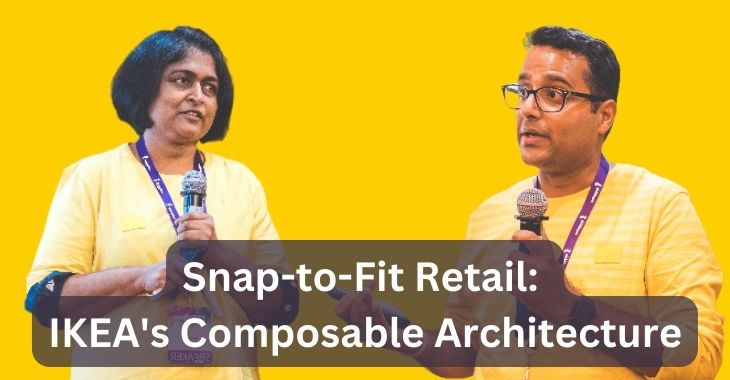
“Once again Saltmarch has knocked it out of the park with interesting speakers, engaging content and challenging ideas. No jetlag fog at all, which counts for how interesting the whole thing was."
Cybersecurity Lead, PwC

In a recent conversation that was as much about strategy as it was about tech, Varun Nagalia and Swapnila Khatkale from Genesis, the digital powerhouse behind IKEA, unpacked how the iconic Swedish retailer is not just surviving but thriving in a digitally-driven market.
“IKEA is not just a furniture retailer; it's a brand that's diversifying into various sectors like financial services and renewable energy. We're focusing on creating a circular economy around furniture, encouraging customers to buy back and recycle,” Varun Nagalia
Nagalia kicked things off with a nostalgia-infused primer on IKEA's journey from a Swedish start-up to a global retail behemoth. Despite its 80-year-long history, IKEA is showing no signs of slowing down. Operating in over 40 countries and raking in billions, IKEA has always been a trailblazer in retail, introducing innovations like flat-pack furniture and a strong focus on customer experience.
The COVID-19 pandemic has been a catalyst for digital transformation across industries, and IKEA is no exception. The acceleration of online shopping, coupled with restrictions on physical retail spaces, has made a compelling case for a more potent and agile digital strategy. It's fascinating to see how IKEA’s Genesis division navigated these turbulent waters, tweaking the company's online interfaces to handle increased traffic and rolling out contactless delivery options.
But the discussion at Great International Developer Summit wasn't just a trip down memory lane. Nagalia highlighted how IKEA's digital division, Genesis, has become the linchpin in the brand's transformative efforts. And get this—IKEA isn't merely a furniture vendor anymore. The brand is widening its horizons by venturing into diverse sectors like financial services and renewable energy. Plus, they're committed to fostering a circular economy, encouraging consumers to recycle and repurchase furniture.
What's even more intriguing about IKEA's digital journey is how the brand is leveraging artificial intelligence and data analytics to streamline operations and provide a personalized customer experience. While AI algorithms are being used to optimize supply chain logistics, data analytics offer a window into customer preferences, helping the company adapt its product lineup according to market demands. This shows that IKEA's commitment to digital transformation isn't merely superficial; it's profoundly data-driven and intelligent.
It's also worth mentioning that cybersecurity is a cornerstone of IKEA's digital endeavors. As Varun Nagalia pointed out in a previous interview, a robust digital presence is invariably tethered to the responsibility of protecting customer data. IKEA is investing heavily in cybersecurity measures to ensure that its digital expansion doesn't compromise customer trust. This is a facet often overlooked in digital strategies but one that IKEA places in high regard.
“Our goal is not just to have a functional website but to build an organization that leads with digital DNA. Transparency and easy access to data are crucial for this transformation”, Swapnila Khatkale
Swapnila Khatkale, stepping up to the plate, provided a compelling narrative around IKEA's digital strategy—a roadmap that's deeply anchored in human-centric design principles. The objective here isn't just a snazzy website or an app that functions. Instead, IKEA wants to cultivate a company culture that's infused with digital proficiency. Transparency and effortless access to data form the pillars of this transformation, allowing IKEA to deliver stellar products and services to consumers at lightning speed.
But the pièce de résistance of the discussion was, without a doubt, the radical notion of composable architecture. In layman's terms, it’s like snapping together LEGO blocks, or more aptly, assembling IKEA furniture. This modular approach rests on the pillars of microservices, APIs, cloud-native solutions, and headless systems.
“Composable architecture offers three main advantages: flexibility, speed to market, and cost-effectiveness. It allows for quick adaptations, enabling businesses to meet changing customer needs and market conditions”, Srinivas Verma
Enter Srinivas Varma, an engineering manager at IKEA, who doubled down on the benefits of this architecture. He underscored three key advantages: nimbleness, quick time-to-market, and cost efficiency. This means companies can now deftly pivot to meet fluctuating market demands and consumer expectations with minimal fuss.
What's also ground-breaking is the shifting perception of IT from an isolated wing to a vital organ of the enterprise. Far from being just a tech gimmick, this architecture is instrumental in propelling business results. IKEA is waving goodbye to outdated, rigid systems and embracing this more adaptive, modular framework. The overarching goal? Create better stores, enhance lives, and protect the planet.
“The focus is not just on adopting new technologies but on a holistic transformation that puts people at the center. We're on a massive journey to transform from a large retailer in Europe to a global omni-channel retailer”, Varun Nagalia
Wrapping things up, the discourse by Nagalia, Khatkale, and Verma provided a treasure trove of insights, casting light on how a conventional retail mammoth is reinventing itself for a digitally-dominated era. The emphasis isn’t just on flashy tech adoption but on a comprehensive metamorphosis that keeps humanity at its core. Composable architecture stands out as a vital tool, granting the agility and adaptability required to navigate a business world that's always in flux.
In a landscape where the only predictability is unpredictability, IKEA's strategic blueprint emerges as an invaluable reference for any business aiming to evolve. It’s a captivating narrative that underscores the continual need for even the most well-established brands to adapt or risk obsolescence.
Finally, one can't overlook IKEA's commitment to sustainability, which finds its way into its digital aspirations as well. The brand's focus on creating a circular economy extends to its IT infrastructure, aiming for energy-efficient data centers and encouraging remote work to reduce carbon footprints. These are not mere talking points but deeply ingrained principles that align IKEA's digital ambitions with its broader mission for global sustainability.
Watch the full video of the talk, here.
Have questions or comments about this article? Reach out to us here.
Banner Image Credits: Swapnila Khatkale (L) and Varun Nagalia (R) at Great International Developer Summit

“Once again Saltmarch has knocked it out of the park with interesting speakers, engaging content and challenging ideas. No jetlag fog at all, which counts for how interesting the whole thing was."
Cybersecurity Lead, PwC

“Very much looking forward to next year. I will be keeping my eye out for the date so I can make sure I lock it in my calendar."
Software Engineering Specialist, Intuit

“Best conference I have ever been to with lots of insights and information on next generation technologies and those that are the need of the hour."
Software Architect, GroupOn

“Happy to meet everyone who came from near and far. Glad to know you've discovered some great lessons here, and glad you joined us for all the discoveries great and small."
Web Architect & Principal Engineer, Scott Davis

“Wonderful set of conferences, well organized, fantastic speakers, and an amazingly interactive set of audience. Thanks for having me at the events!"
Founder of Agile Developer Inc., Dr. Venkat Subramaniam

“What a buzz! The events have been instrumental in bringing the whole software community together. There has been something for everyone from developers to architects to business to vendors. Thanks everyone!"
Voltaire Yap, Global Events Manager, Oracle Corp.